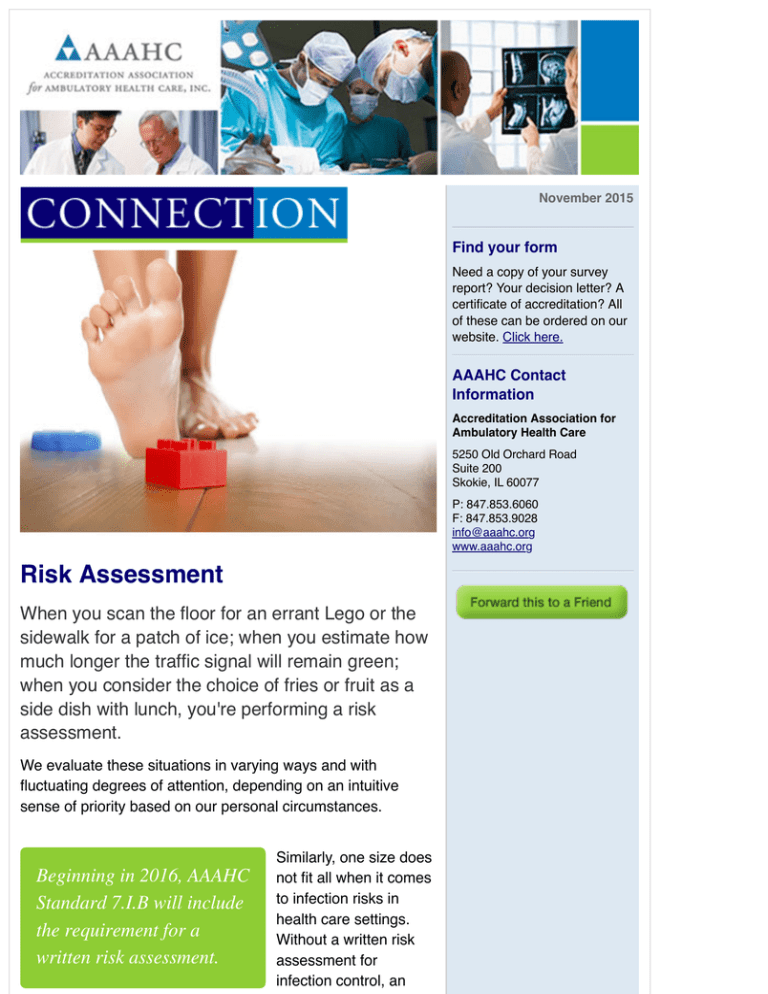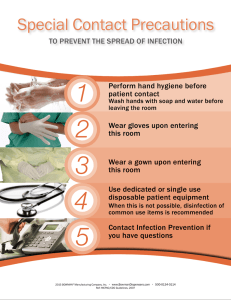
November 2015
Find your form
Need a copy of your survey
report? Your decision letter? A
certificate of accreditation? All
of these can be ordered on our
website. Click here.
AAAHC Contact
Information
Accreditation Association for
Ambulatory Health Care
5250 Old Orchard Road
Suite 200
Skokie, IL 60077
P: 847.853.6060
F: 847.853.9028
info@aaahc.org
www.aaahc.org
Risk Assessment
When you scan the floor for an errant Lego or the
sidewalk for a patch of ice; when you estimate how
much longer the traffic signal will remain green;
when you consider the choice of fries or fruit as a
side dish with lunch, you're performing a risk
assessment.
We evaluate these situations in varying ways and with
fluctuating degrees of attention, depending on an intuitive
sense of priority based on our personal circumstances.
Beginning in 2016, AAAHC
Standard 7.I.B will include
the requirement for a
written risk assessment.
Similarly, one size does
not fit all when it comes
to infection risks in
health care settings.
Without a written risk
assessment for
infection control, an
organization’s infection
surveillance, prevention and control program (ISPC) is often
piecemeal and can fail to address the significant infection
control risks that are present in every facility. For that reason,
beginning in 2016, AAAHC Standard 7.I.B will include the
requirement for a written risk assessment. Where do you start
and what should it look like?
AAAHC does not mandate how the risk assessment must be
done, but developing and using a tool will make it easier. If you
already have a tool that is working well, stick with it! Just be
sure that whatever you use identifies risks and ranks them.
You can’t fix everything in a day, so weighing the relative risk
provides a framework for prioritizing what should be addressed
first, second, and so on.
Infection Control Risk Categories
Do your policies cover all relevant infection control issues? Are
they accessible, up-to-date with current references, and do
they reflect actual practice? Here is a series of topics to get
you thinking about risks in your own organization. Note: The
list of risk areas below is intended to umpstart your thinking
about what to include for your facility. It is not intended to be
all-encompassing.
The community and population you serve – What is the
population that comes to your facility? Elderly eye patients
having cataract removals or young athletes with sports
injuries? What diseases and conditions are found in your
area? Is TB an issue? Are there high rates of HBV or HCV in
the area? Other communicable diseases? What are the
socioeconomics of the area and what is the effect on access to
healthcare and/or compliance with recommendations?
Your staff and providers – Do your policies address:
exclusion from work for certain illnesses, immunizations,
education on infection control (in general and job-specific) for
all personnel, including providers and contracted services like
housekeeping? Exposure to cleaning, disinfection and
sterilization chemicals? Dress code and, especially, proper OR
attire? Are there competency evaluations for staff members
performing complex tasks like blood glucose monitoring,
disinfection or sterilization of scopes and/or surgical
instruments?
Your environment of care – Perform a scan of your entire
facility. Beyond infectious waste, look at sharps and general
waste management; where food and beverages may be
consumed and where they are not permitted; how your spaces
and equipment are cleaned, by whom, and with what products;
the layout and flow of soiled and clean utility rooms; air
pressure and direction, etc.
Your care practices – How do you screen patients and
escorts for communicable disease? What isolation precautions
and use of PPE do you practice? Include specific policies on
invasive procedures and other practices.
Your medication practices – Lack of adherence to the CDC
Safe Injection Practices is a high risk issue; unsafe practices
have led to transmission of HBV and HCV. How do you
manage multi-dose and single dose vials, narcotic control,
sample medications, refrigeration of medications, use of
devices such as safety needles, IV safety needles, safety
lancets, etc.?
Disinfection and sterilization – I. Of medical equipment: Is
every item used on a patient cleaned and disinfected between
use (BP cuffs, stethoscopes, pulse oximeter probes, etc.)? Is
there clear communication of who is to do this? Are the correct
cleaning products being used?
II. Of surgical instruments and endoscopes: If not done
correctly, this can lead to transmission of pathogens that cause
infections. Is quality monitoring for high-level disinfection and
sterilization done consistently and recorded? Do staff know
what to do if they get an abnormal result? Are clean operations
segregated? Are instruments and scopes stored properly? Are
temp and humidity checked daily and logged? Are the most
current manufacturer’s instructions for use (IFUs) available
and followed?
Surveillance – Do you track outcomes like SSIs and other
infections? Process measures like disinfection and sterilization
practices? Hand hygiene compliance monitoring is a CMS
requirement. Tracking and reporting these metrics establishes
benchmarks for your organization and can drive improved
compliance.
Your emergency management plan – What natural disasters
are common to your area? Do you have plans to deal with loss
of power, loss of water, or other situations where resources are
not available? If expected to shelter in place, do you have
supplies of food and water? Is there the possibility of an influx
of infectious patients, and are there supplies and equipment
available if that should happen? Has your facility coordinated
with the community’s emergency management authority, so
that your staff knows what their role will be in an emergency?
Ranking Criteria
Once you’ve identified the issues, grade them based on four
criteria:
1. What is the probability of the event occurring?
High=3
Med=2
Low=1
None=0
2. What is the degree of risk?
High=3, Serious injury, death
Med=2, Permanent harm
Low=1, Temporary harm to patients or staff
None=0
3. What is the potential impact on care, treatment or
services?
High=3
Med=2
Low=1
None=1
4. How prepared is your organization to respond to the
problem?
None=3
Low=2
Med=1
High=0
Total the points for each risk area. The highest possible score
would be 12 for a specific risk. The higher the number, the
greater the risk and the higher the priority for attention. There
will be risks identified that will require budgeting for the future,
such as separating clean and soiled utility rooms. These will
take planning and time to get the project funded and
underway. Again, you can’t do it all in a day!
Your assessment in action
When you’ve identified and ranked the risks, write a goal for
each priority issue. Here is one example:
Risk: No hand hygiene monitoring.
Goal: A hand hygiene monitoring program will be in
place not later than April 1, 2016. Compliance will be
measured by secret shoppers with a compliance rate
of 60%. Note that the goal is SMART (Specific,
Measurable, Achievable, Relevant and Timebound).
Objective: A sustainable hand hygiene program will
be established to include: leader sponsorship, staff
education, alcohol based handrub placed at
appropriate locations, observers trained and
assigned, a form developed for the observers.
The collective goals and objectives become the Infection
Surveillance Prevention and Control Program for the
organization. Since the goals are measurable, they can be
used to evaluate the program. The infection preventionist will
also develop his or her own personal goals and objectives, tied
into the risk assessment goals and objectives.
Once you do this, you’ll wonder how you worked without it!
Remember, your risk assessment is a living document that is
updated frequently as new problems or issues are identified.
- Marsha Patrick, RN, CIC
If you have questions or comments about Connection, please contact Angela FitzSimmons at
afitzsimmons@aaahc.org.
© 2015 AAAHC. All Rights Reserved.






